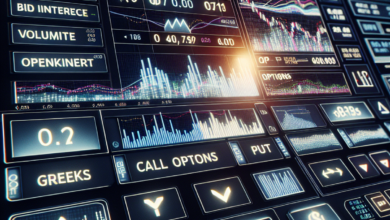Case Study: Successful Use of FX Options in Corporate Treasury

Introduction
FX options are a crucial financial instrument in corporate treasury, providing the right—but not the obligation—to buy or sell a currency at a specified exchange rate within a defined timeframe. These options are used to hedge against foreign exchange risk, which can significantly impact a company’s financial performance.
Managing currency risk is essential for businesses operating in global markets. Fluctuations in exchange rates can lead to unpredictable costs, affecting profitability and competitive positioning. By employing FX options, companies can mitigate these risks and enhance financial stability.
This article presents several case studies demonstrating the successful use of FX options in corporate treasury. Each case offers insights into how different companies have faced unique challenges and employed strategic hedging techniques to safeguard their financial health.
Explore the various ways FX options can be a valuable tool for your business:
- Swiss Franc Stability for a Swiss Manufacturer
- Hedging Future Payments for a UK Importer
- Protecting Revenue for a European Software Company
- Managing Currency Risk for a Global Retailer
These real-world examples emphasize how FX options contribute to effective currency risk management and improved financial performance.
To further enhance your understanding of FX options, it is important to grasp concepts like historical volatility vs implied volatility. This knowledge will help you uncover how past market trends and expected fluctuations shape your trading strategy.
You should also familiarize yourself with option moneyness, as it is key to advanced strategies. Understanding option moneyness will unlock tactics of savvy trading and enable you to maximize profits in the US market.
Additionally, learning about put options will provide you with insights into this strategic tool for investors in the U.S stock market. Discover how this financial mechanism works and its potential perks.
By leveraging FX options, businesses can achieve greater financial resilience and navigate the complexities of international markets with confidence.
Case Study 1: Swiss Franc Stability for a Swiss Manufacturer
Swiss Franc stability poses significant challenges for Swiss manufacturers, particularly in managing currency risk. One such manufacturer faced substantial exposure to the EUR/CHF exchange rate due to its extensive business dealings within the Eurozone. This exposure necessitated an effective hedging strategy to mitigate potential financial losses.
Challenges Faced:
- Volatility in the EUR/CHF exchange rate
- Potential for substantial financial impact from adverse currency movements
- Need to maintain competitive pricing and profit margins
Strategic Approach:
The company adopted a strategic hedging approach focused on EUR/CHF put options. These options provided the right, but not the obligation, to sell euros at a predetermined rate, thereby offering protection against unfavorable exchange rate movements.
Key Elements of the Strategy:
- Selection of EUR/CHF Put Options: Ensured protection against depreciation of the euro.
- Incorporating Implied Volatility Consideration: Factored in implied volatility for optimal option pricing.
- Timing and Execution: Carefully timed the purchase and execution of options to align with exposure periods.
Outcome and Benefits:
The hedging strategy yielded significant benefits:
- Financial Stability: The company effectively mitigated currency risk, ensuring stable cash flows.
- Competitive Edge: Maintained competitive pricing without compromising profit margins.
- Enhanced Financial Performance: Improved overall financial health through prudent risk management.
This case study exemplifies how utilizing FX options like EUR/CHF put options can stabilize financial positions and support business continuity amidst currency volatility. Additionally, it demonstrates how such strategies are successfully employed by Swiss manufacturers in managing their currency risk, as evidenced by this research article.
Case Study 2: Hedging Future Payments for a UK Importer
Understanding the intricacies of currency risk is crucial for businesses involved in international trade. A UK importer, heavily reliant on USD for its transactions, faced significant exposure to GBP/USD fluctuations. This exposure threatened their cost structure and profitability.
Challenges Faced:
- Exchange Rate Volatility: The importer dealt with unpredictable GBP/USD movements, complicating budgeting and financial planning.
- Cost Management: Fluctuating rates impacted the cost of goods purchased from US suppliers, affecting overall financial stability.
Strategic Approach:
To mitigate these risks, the company used FX call options. These options provided the right to purchase USD at a predetermined rate, offering protection against adverse currency movements.
Implementation Steps:
- Assessment of Exposure: Identified periods of high purchasing activity and corresponding payment schedules.
- Selection of Option Type: Chose FX call options tailored to specific future payment dates.
- Premium Payment: Paid a premium for the options, balancing cost against potential savings from favorable exchange rates.
Outcomes and Benefits:
- Cost Predictability: Secured a maximum exchange rate for future purchases, simplifying financial forecasting.
- Financial Stability: Stabilized cash flows by mitigating adverse currency impacts.
- Strategic Flexibility: Retained the potential upside if GBP strengthened against USD.
The use of FX call options not only safeguarded the importer’s cost structure but also enhanced their overall financial resilience amidst market volatility.
For deeper insights on managing implied volatility in hedging strategies, you might find this article useful.
Exploring these strategic approaches can significantly benefit corporate treasuries dealing with similar challenges. It’s worth considering momentum trading techniques to take advantage of market trends. Additionally, understanding the differences between systematic and unsystematic risk can help navigate investments wisely. Lastly, incorporating neutral options strategies into your portfolio can provide a winning edge in any market condition.
Case Study 3: Protecting Revenue for a European Software Company
This case study explores the currency risk dynamics faced by a European software company. Operating in a highly competitive market, the company generated significant revenue from international clients, predominantly invoicing in USD. The volatility of the EUR/USD exchange rate posed substantial risks to their revenue, necessitating an effective hedging strategy.
Strategic Approach: EUR/USD Put Options
To mitigate these risks, the company implemented a strategic approach using EUR/USD put options. This financial instrument provided them with the right, but not the obligation, to sell USD at a predetermined rate within a specific timeframe. By locking in favorable exchange rates, they could protect their revenue against adverse currency movements.
Key elements of their strategy included:
- Assessment of Risk Exposure: Identifying periods of high revenue generation and corresponding exchange rate volatility.
- Selection of Put Options: Choosing options with strike prices aligned with their budgeted exchange rates.
- Regular Review: Continuously monitoring market conditions and adjusting their hedging portfolio accordingly.
Impact on Financial Stability and Growth
The adoption of FX options safeguarded the company’s revenue stream from unfavorable currency fluctuations. This stability enabled them to:
- Maintain consistent profit margins
- Plan more effectively for future investments
- Support international growth initiatives
The success of this strategy showcased how FX options can be an invaluable tool in managing currency risk for businesses with significant foreign exposure.
Case Study 4: Managing Currency Risk for a Global Retailer
Managing currency risk is a critical task for any global retailer operating across multiple regions. This company faced significant exposure due to its extensive geographical presence, necessitating a diversified hedging strategy.
To tackle these challenges, the retailer adopted a combination of FX call and put options. This approach allowed them to hedge against adverse currency movements effectively. They strategically employed:
- FX Call Options: To protect against unfavorable currency appreciation, ensuring that costs for importing goods did not spiral out of control.
- FX Put Options: To guard against currency depreciation, securing revenue from international sales.
This strategy provided flexibility, allowing the retailer to manage exposures dynamically as market conditions changed. The positive impact on their financial performance was evident:
- Enhanced Profit Margins: By mitigating currency risk, the company could maintain stable profit margins despite fluctuating exchange rates.
- Improved Financial Stability: The diversified approach reduced volatility in financial statements, contributing to overall financial resilience.
The case of this global retailer underscores the importance of a well-rounded hedging strategy tailored to specific operational needs and geographical spread.
Conclusion
Successful Use of FX Options in Corporate Treasury offers businesses a robust framework for managing currency risk. The key benefits include:
- Flexibility: FX options provide the right, but not the obligation, to buy or sell currencies, offering more flexibility compared to other hedging instruments.
- Risk Mitigation: By locking in exchange rates, companies can protect themselves against unfavorable currency movements.
- Financial Performance Enhancement: Effective use of FX options can lead to improved financial stability and profitability.
Exploring these strategies within your own corporate treasury can significantly enhance financial resilience. Properly leveraging FX options can be a game-changer in navigating volatile currency markets.
For those wanting to dive deeper into related topics, consider exploring our guides on FX Spot vs FX Options Trading and Rolling Options. The former provides an insightful comparison between FX Spot and FX Option trading, enabling you to make informed financial decisions. Meanwhile, the latter explores how to master the art of rolling options to maximize profits and elevate your trading strategies.
By integrating these practices thoughtfully, you can optimize your company’s hedging strategy and better manage foreign exchange risks.







